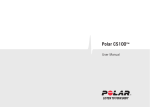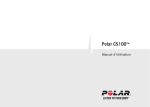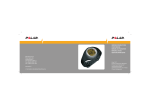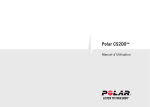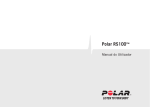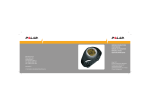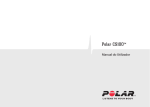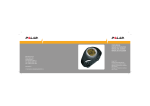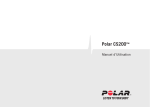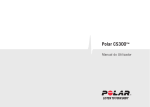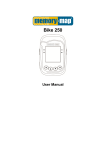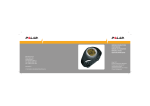Download Polar CS200 User Manual
Transcript
Polar CS200™ User Manual CS200 / CS200cad QUICK GUIDE Files mode: View detailed information on your latest exercise sessions. Totals mode: View the long-term information on your exercises. Settings mode: Change time of day, and other settings. Connect mode: Transfer the settings from your PC to your cycling computer and send your exercise data to the web service. Press 2 x LEFT button ENG View the date and time of day. RIGHT RIGHT MIDDLE Exercise mode: Monitor and record your exercise information, such as your heart rate, speed and distance. MIDDLE Date / Time of the latest File RIGHT Date / Time of the previous Files (scroll them by pressing the RIGHT button) RIGHT Delete FILES RIGHT RIGHT MIDDLE MIDDLE Tot.Time / Date Cycling SET RIGHT RIGHT Tot.Kcal / Date Timer SET RIGHT RIGHT Odometer / Date Limits SET Odometer1 RIGHT Odometer2 (if in use) Bike SET RIGHT RIGHT Distance1 / Date Watch SET Distance2 (if in use) RIGHT RIGHT User SET MaxSpeed / Date RIGHT RIGHT General SET Max.Cad* / Date RIGHT *Optional Polar Cadence Sensor required. RideTime / Date 37 MIDDLE Send FILES RIGHT Receive DATA BUTTONS Note: Pressing a button briefly has a different effect than pressing and holding the button for a longer period of time: • Normal press: press and release the button. • Long press: press and hold the button (for at least one second). Use long presses for shortcuts (described in the main modes). LEFT • Stop or pause the exercise recording. • Cancel the function. • Exit the menu and return to the previous level of the menu. • Return to the Time mode from any mode (press and hold the button for at least one second except in Exercise mode press the button twice). RIGHT • Move to the next mode or menu level. • Increase the selected value. RIGHT LEFT MIDDLE 38 MIDDLE • Start the exercise recording. • Accept the function. • Enter the displayed mode or menu and move to a lower menu level. • Exercise mode: - record lap information (lap) during your exercise • Turn the backlight on in all modes (press and hold the button for at least one second). CONTENTS The information relevant to using the product with the cadence sensor is in blue text. 1. INTRODUCTION TO THE POLAR CYCLING COMPUTER ........................................................................................................7 1.1 PRODUCT ELEMENTS ...............................................................................................................................................7 1.2 USING YOUR CYCLING COMPUTER FOR THE FIRST TIME...........................................................................................8 1.3 INSTALLING THE BIKE MOUNT, CYCLING COMPUTER, SPEED AND CADENCE SENSORS...........................................12 1.3.1 Bike Mount and Cycling Computer .............................................................................................................12 1.3.2 Speed Sensor ..............................................................................................................................................13 1.3.3 Cadence Sensor ..........................................................................................................................................15 1.4 WEARING YOUR TRANSMITTER ...............................................................................................................................17 2. EXERCISING ....................................................................................................................................................................18 2.1 EXERCISE RECORDING AND HEART RATE MEASURING ...........................................................................................18 2.2 FUNCTIONS DURING EXERCISE ..............................................................................................................................20 2.3 STOPPING THE EXERCISE AND VIEWING SUMMARY FILE .........................................................................................25 3. VIEWING RECORDED INFORMATION - FILE .....................................................................................................................27 3.1 VIEWING EXERCISE FILE .........................................................................................................................................27 3.2 DELETING FILES ONE BY ONE .................................................................................................................................31 4. TOTAL VALUES .................................................................................................................................................................32 5. SETTINGS ........................................................................................................................................................................37 5.1 RIDING DISTANCE FOR ESTIMATED TIME OF ARRIVAL FUNCTION AND AUTOMATIC LAP RECORDING SETTINGS (CYCLING SET) .........................................................................................37 5.2 TIMER SETTINGS (TIMER SET) ................................................................................................................................39 ENGLISH 39 5.3 5.4 5.5 5.6 5.7 HEART RATE LIMITS SETTINGS (LIMITS SET) ...........................................................................................................40 5.3.1 OwnZone.....................................................................................................................................................42 BICYCLE SETTINGS (BIKE SET) ...............................................................................................................................45 WATCH SETTINGS (WATCH SET) ..............................................................................................................................49 PERSONAL INFORMATION SETTINGS (USER SET) ....................................................................................................51 CYCLING COMPUTER SOUNDS AND UNITS SETTINGS (GENERAL SET) .....................................................................54 6. CONNECT - DATA COMMUNICATION ................................................................................................................................55 6.1 EDIT SETTINGS WITH A COMPUTER .........................................................................................................................55 6.2 TRANSFER YOUR TRAINING DATA TO THE TRAINING DIARY ON THE WEB ................................................................56 7. CARE AND MAINTENANCE ................................................................................................................................................57 8. PRECAUTIONS .................................................................................................................................................................60 9. FREQUENTLY ASKED QUESTIONS .....................................................................................................................................62 10. TECHNICAL SPECIFICATIONS ..........................................................................................................................................64 11. LIMITED POLAR INTERNATIONAL GUARANTEE .................................................................................................................66 12. POLAR DISCLAIMER ........................................................................................................................................................67 13. INDEX ..............................................................................................................................................................................68 6 – ENGLISH ENG – 5 1. INTRODUCTION TO THE POLAR CYCLING COMPUTER 1.1 PRODUCT ELEMENTS Polar WearLink™ Coded Transmitter The connector transmits your heart rate signal to the cycling computer. The electrode areas of the strap detect your heart rate. The Polar cycling computer package consists of the following parts: Cycling Computer The cycling computer displays and records your cycling and exercise data during exercise. Enter your personal settings into the cycling computer and analyze exercise information after workouts. Polar Bike Mount™ Secure the bike mount to your bike and attach the cycling computer to it. Polar Speed Sensor™ A wireless speed sensor measures speed and distance during cycling. Polar Cadence Sensor™ CS200cad set includes a cadence sensor. The wireless cadence sensor measures the speed at which you turn the pedals of your bicycle. The information relevant to using the product with the cadence sensor is in a blue text. CS200 set does not include a cadence sensor, but you can buy it as an accessory product. Polar Web Services www.polarpersonaltrainer.com is a complete web service tailored to support your training goals. Free registration gives you access to a personalized training program, training diary, useful articles, and much more. In addition, you can get the latest product tips and support online at www.polar.fi. Customer Service and International Guarantee Information If your cycling computer needs repair, send it with a Return Card for service to your Polar Service Center. The two-year Polar guarantee is issued to the original customer/purchaser of the product. Please keep the receipt and stamped Polar Customer Service Card. The receipt is your proof of purchase! The latest version of this user manual can be downloaded at www.polar.fi/support. ENGLISH 40 1.2 USING YOUR CYCLING COMPUTER FOR THE FIRST TIME Enter your settings in the Basic Settings mode (time, date, units, and personal settings). How to enter Basic Settings Entering accurate personal information ensures that you receive correct feedback based on your performance (calorie consumption, OwnZone determination etc). Activate the cycling computer by pressing the MIDDLE button. The display fills with numbers and letters. 1. Press the MIDDLE button. BASIC SET is displayed. 2. Continue by pressing the MIDDLE button and follow the steps below: The display reads: 3. Time Set • Time Mode 24h / 12h • AM / PM (for 12h format) 8 – ENGLISH Press the RIGHT button to set the flashing value Press the MIDDLE button to accept the value RIGHT • Set 24h or 12h format. MIDDLE RIGHT • Set AM or PM. MIDDLE – 7 The display reads: Press the RIGHT button to set the flashing value Press the MIDDLE button to accept the value • Hours RIGHT • Set the hours.* MIDDLE • Minutes RIGHT • Set the minutes.* MIDDLE RIGHT • Set the day (in 24h format) or the month (in 12h format).* MIDDLE • Month / Day RIGHT • Set the month (in 24h format) or the day (in 12h format).* MIDDLE • Year RIGHT • Set the year.* MIDDLE 4. Date Set** • Day / Month Note: • *The numbers scroll faster if you press and hold the RIGHT button as you adjust the value. • **The date will be displayed according to the time format selected (24h: day - month - year / 12h: month - day - year). • After a change of battery or after you reset the cycling computer, you only need to set the time and date in the Basic Settings. You can skip the rest of the settings by pressing and holding the LEFT button. ENGLISH 41 The display reads: Press the RIGHT button to set the flashing value Press the MIDDLE button to accept the value 5. Unit kg/cm or lb/ft RIGHT • Set the units for weight and height: kg/cm or lb/ft. MIDDLE 6. Weight kg/lb RIGHT • Set your weight in kilograms or pounds. MIDDLE Note: If you chose the wrong units, you can still change them by pressing the LEFT button and returning to step 5. 7. Height cm/ft RIGHT • Set your height in cm or ft. • Set inches (if you chose lb/ft). MIDDLE 8. Birthday • Day / Month RIGHT • Set the day (in 24h format) or the month (in 12h format). MIDDLE • Month / Day RIGHT • Set the month (in 24h format) or the day (in 12h format). MIDDLE • Year RIGHT • Set the year. MIDDLE 10 – MIDDLE ENGLISH ENG – 9 The display reads: Press the RIGHT button to set the flashing value Press the MIDDLE button to accept the value 9. Sex Male / Female RIGHT • Set male or female. MIDDLE • Settings done is displayed. • To change your settings, press the LEFT button until you return to the desired setting. • To accept the settings, press the MIDDLE button and the cycling computer goes to the Time mode. The cycling computer goes to the power save mode (blank screen) by pressing the LEFT button or if you do not press any button in the Time mode for five minutes. You can turn the cycling computer on again by pressing any button. ENGLISH 42 1.3 INSTALLING THE BIKE MOUNT, CYCLING COMPUTER, SPEED AND CADENCE SENSORS 1.3.1 BIKE MOUNT AND CYCLING COMPUTER 1. You can install the bike mount and the cycling computer on the left or right side of the handlebar or on the stem with cable ties. 2. 2. Place the rubber part on the handlebar or stem and insert the bike mount on top of it. 3. 3. Pass the cable ties over the bike mount and adjust them around the handlebar/ stem. Secure the bike mount firmly. Cut off any excess cable tie ends. 12 – ENGLISH 4. Position the cycling computer on to the bike mount. Turn the cycling computer clockwise until you hear a click. You can release the cycling computer by pressing it down and simultaneously turning it counter clockwise. – 11 1.3.2 SPEED SENSOR To install the speed sensor and spoke magnet, you need cutters and a small screwdriver. 1. Attach the speed sensor to the opposite side of the front fork from the mounted cycling computer. The speed sensor and the cycling computer should be no more than 30-40 cm/ 1’-1’3’’ apart. In case, the cycling computer is attached to the stem or if you are exercising in surroundings with electromagnetic interference, the distance should be minimized (minimum 30 cm/1’). The speed sensor and cycling computer should form approximately a 90° angle. 2. 2. Attach the rubber part to the sensor. 3. 3. Pass the cable ties through the speed sensor and rubber part holes. Should the distance between the cycling computer and the speed sensor be longer than recommended (for example on mountain bikes due to the front suspension), the speed sensor could be attached on the same side of the front fork as the cycling computer. In this case the maximum distance is 50 cm/1´6”. 4. 4. Adjust the sensor to the front fork so that the POLAR logo faces outwards. Adjust the ties loosely. Do not tighten them fully yet. 1. ENGLISH – 43 5. Attach the magnet to a spoke at the same level as the sensor. The magnet hole must be facing the speed sensor. Fasten the magnet to the spoke and tighten it loosely with a screwdriver. Do not tighten it fully yet. 5. max 4 mm / 0’16” Fine-tune the positioning of both the magnet and the speed sensor so that the magnet passes close to the sensor but does not touch it. Adjust the sensor towards the wheel/ spokes as much as possible. The gap between the sensor and the magnet should be under 4 mm/0’16’’. The gap is correct when you can fit a cable tie just about between the magnet and the sensor. Your safety is important to us. While riding your bike, please keep your eyes on the road to prevent any accidents and injury. Check that you can turn the handlebar normally and that the cable wires for brakes or gearing do not catch on the bike mount or the sensors. Check also that the bike mount or sensors does not hamper pedaling or the use of brakes or gearing. Before you start cycling, you should set the wheel size of your bicycle into the cycling computer. For further information see pages 45-48. Rotate the front tyre so that you can see a speed reading on the display of your cycling computer. The reading indicates that the magnet and the speed sensor are positioned correctly. Once the magnet and the speed sensor are positioned correctly, tighten the screw to the magnet with a screwdriver. Also tighten the cable ties securely and cut off any excess cable tie ends. 14 – ENGLISH ENG 13 1.3.3 CADENCE SENSOR To install the cadence sensor and crank magnet, you need cutters. 1. max 80 cm / 2’6’’ 2 A. 1. Check the down tube to find a suitable place for the cadence sensor. The sensor should be attached at a maximum of 80 cm/ 2’6” from the mounted cycling computer. If needed the sensor can also be attached to the seat tube. 2. Place the rubber part on to the cadence sensor (A) and pass the cable ties through the cadence sensor and rubber part holes (B). 2 B. 3. Clean and dry a suitable place for the sensor and adjust the sensor to the down tube. If the sensor touches the crank (when rotating), change the sensor’s position slightly upwards. Loosely adjust the cable ties. Do not tighten them fully yet. 3. 4. The crank magnet should be installed vertically on the inner side of the crank. Before attaching the magnet to the crank, the area should be cleaned and dried thoroughly. Attach the magnet to the crank and secure with the tape. 4. ENGLISH 44 5. max 4 mm / 0’16’’ 5. Fine-tune the positioning of both the crank magnet and the sensor so that the magnet passes close to the sensor without actually touching it. The maximum distance between the cadence sensor and the crank magnet should be 4 mm/0’16”. The gap is correct when you can fit a cable tie just about between the magnet and the sensor. It is important that the lower corner of the sensor must face the magnet when rotating, also when the sensor has been attached to the seat tube. The lower corner of the sensor is shown with an arrow in the picture. Once the crank magnet and the sensor are positioned correctly, tighten the cable ties securely and cut off any excess cable tie ends. 16 – ENGLISH Before you start cycling, you should set the wheel size of your bicycle into the cycling computer and turn the cadence function on. For further information see pages 45-48. – 15 1.4 WEARING YOUR TRANSMITTER Coded heart rate transmission reduces interference from other heart rate monitors that are close by. To make sure that the code search is successful and to ensure trouble-free heart rate monitoring, keep the cycling computer within 1 meter/ 3 feet of your transmitter. Check that you are not near other people with heart rate monitors or any source of electromagnetic disturbance. For further information on interference, see Precautions on page 60. To measure your heart rate, you need to wear the transmitter. 1. Moisten the electrode areas of the strap under running water and make sure that they are well moistened. 2. Attach the connector to the strap. Position the letter L on the connector next to the word LEFT on the strap and snap the fastener. Adjust the strap length to fit snugly and comfortably. Secure the strap around your chest, just below your chest muscles, and snap the second fastener. 1. 3. Check that the wet electrode areas are firmly against your skin and that the Polar logo of the connector is in a central, upright position. 2. See the following chapter for how to start measuring your heart rate. 3. To detach the connector from the strap, apply pressure with your thumb and forefinger and turn your hand as indicated in the picture. Note: If the cycling computer does not display your heart rate, make sure that the transmitter electrodes are moist and that the strap is snug enough. ENGLISH – 45 2. EXERCISING 2.1 EXERCISE RECORDING AND HEART RATE MEASURING You can record seven Exercise Files. There are two ways to start exercise recording. If you turn on the AutoStart function, the cycling computer automatically starts and stops exercise recording when you start and stop cycling. If the AutoStart function is off, you can start exercise recording by pressing the MIDDLE button. For further information on AutoStart and how to set the function on/off, see pages 45-46. 1. Wear the transmitter as described in the section “Wearing your Transmitter” on page 17. Attach the bike mount, speed and cadence sensors on your bicycle according to the instructions on pages 12-16. 2. Activate your blank cycling computer by pressing the MIDDLE button and start from the Time mode. The cycling computer will automatically read your heart rate. Wait until the computer detects your heart rate and the framed, flashing heart appears on the display in 15 seconds.* Exercise time is not recorded yet. symbol 3. Set your cycling computer on the bike mount. • If you have turned AutoStart on, your heart rate value and speed appear on the display when you start cycling. • If you have turned AutoStart off, you can start exercise recording by pressing the MIDDLE button when your heart rate value and speed appear on the display. Your exercise time also starts running. 4. • If you have turned AutoStart on, the cycling computer automatically stops exercise recording when you stop cycling. • If AutoStart is off, you can stop the exercise by pressing the LEFT button twice. For further information on Stopping the exercise, see page 25. 18 – ENGLISH ENG 17 • If your heart rate is not displayed and 00 appears on the display, the heart rate detection has stopped. Bring the cycling computer near the Polar logo on the transmitter to restart the heart rate detection. No button press is needed. • If OwnZone® is selected, the OwnZone determination procedure begins when exercise recording starts. For further information, see the section OwnZone on page 42. • To skip the OwnZone determination and use the previously determined OwnZone, press the MIDDLE button when OwnZone symbol appears on the display. If you have not determined your OwnZone before, your age-based heart rate limits will be used. Note: * A frame around the heart rate symbol indicates a coded heart rate transmission. • If the cycling computer does not display your heart rate, make sure that the transmitter electrodes are moist and that the strap is snug enough. ENGLISH – 46 2.2 FUNCTIONS DURING EXERCISE Note: Your exercise information is saved only if the stopwatch, i.e. your exercise duration, has been running for more than one minute or at least one lap has been stored. Changing the display information: Press the RIGHT button to view the following options during exercise: Ridden distance alternates with trip distance when you have taken at least one lap time. 1. Trip distance is reset to zero each time you take a lap time by pressing the MIDDLE button. Riding speed (km/h or m/h) Cadence, i.e., your pedaling speed Heart rate. If there is no heart rate reading or you have not set your user information, the speed is displayed instead. Speed and heart rate are also displayed graphically. The more bars are displayed, the higher your heart rate or speed and vice versa. One speed bar represents 5 km/h or 3 mph, and when all ten bars are displayed your speed is 50 km/h or 30 mph or higher. Note: You can also press and hold the RIGHT button to set the computer to browse the views automatically. Scrolling can be turned off by pressing and holding the RIGHT button. 20 – ENGLISH 19 2. Average speed rise or drop indicator. Cadence Heart rate The kilocalories you have burned so far. The cumulation of kilocalories starts as your heart rate is displayed. If there is no heart rate reading or you have not set your user information, the speed is displayed instead of calorie information. 3. Stopwatch, i.e., exercise duration. Cadence Heart rate 4. The estimated time of arrival, or if the riding distance function is off, the speed is displayed instead. If you set the distance you are going to ride, the cycling computer estimates your arrival time to the destination according to your riding speed. For further information, see page 37. Time of day Cadence Heart rate ENGLISH 47 5. Heart rate limits: On the left, you can see your lower heart rate limit and on the right your upper heart rate limit. The heart rate symbol moves left or right according to your heart rate. If the heart symbol is not visible, it means your heart rate is either below the flashing lower heart rate limit or above the flashing upper heart rate limit. In this case an alarm goes on, provided the sounds are turned on. If there is no heart rate reading, the limits are not displayed. For further information, see page 40. Time you have exercised in target zone, i.e., within the heart rate limits. Cadence Heart rate 6. Average heart rate and average heart rate rise or drop indicator during last minute. Current rate of kilocalories burned (kcal/h) alternates with your cycling intensity (kcal/km or kcal/m). If there is no heart rate reading or you have not set your user information, the speed is displayed instead of calorie information. Cadence Heart rate 22 – ENGLISH ENG – 21 Target Zone Alarm: With the Target Zone Alarm you can make sure you exercise at the right intensity. When the target zone heart rate limits are activated, the cycling computer sounds an alarm if you are above or below your heart rate limits. You can set the limits for your target zone in the Settings/Limits SET menu. For further information, see page 40. If you are out of your target zone, the heart rate value starts flashing and the cycling computer beeps with each heartbeat. The symbol in the upper right corner of the display indicates that the Target Zone Alarm sound is activated. Note that the button sounds can also be set on/off in the Settings mode. To turning the sounds on or off, see page 54. Note:Whenheartratelimitsarenotactivated,noTargetZoneAlarmintheexerciserecordingwillsound,norwilltargetzoneinformationbe placedintheSummaryFileorFile. Storing Lap and Split Time: Press the MIDDLE button to store lap and split time. Lap time indicates elapsed time for one lap. Split time is elapsed time from the beginning of the exercise until storing a lap time (for example from the beginning of the exercise until the 4th lap was stored). Lap time Split time Number of the lap Average heart rate calculated from the beginning of the lap. Note: •IfyouhaveactivatedtheAutomaticLapfunctionintheSettingsmode,yourcyclingcomputerautomaticallyrecordslapswhenyoureach thesetdistance,e.g.,everykilometerormile.Forfurtherinformation,seepage37. •Youcanstoreupto50laptimes.Whenthelapmemoryisfull,LapTimeFULLtextwillbedisplayed.Youcantakelaptimesduringyour exercise,buttheyarenolongerrecorded. ENGLISH – 48 Timers: The timers of your cycling computer work during your exercise recording. The cycling computer beeps and shows when the timer time matches. If only timer 1 is on, the same timer beeps always after the set time has elapsed during your exercise. If timer 2 is also on, the timers alternate during your exercise. For further information, see page 39. Pausing Exercise: 1. Press the LEFT button. Exercise recording, stopwatch, and other calculations are paused. 2. To continue, press the MIDDLE button. Exercising in the dark: If you activate the backlight by pressing and holding the MIDDLE button during an exercise recording, the backlight will reactivate automatically during the same exercise every time you press any button. Note: If the maximum file recording time (99 hours 59 min 59 s) is exceeded, the cycling computer beeps, pauses recording and displays HALT. Stop recording by pressing the LEFT button. For further information on how to release memory for new files by deleting files, see page 31. 24 – ENGLISH 23 2.3 STOPPING THE EXERCISE AND VIEWING SUMMARY FILE 1. Press the LEFT button to pause the exercise recording. Paused is displayed. 2. Press the LEFT button. Summary FILE is displayed and following information starts automatically scrolling: Recorded Exercise File Information Duration of recorded exercise. Average heart rate. Limits Heart rate limits used during your exercise (if limits are set). In Zone Time spent in target heart rate zone. Kcal Kilocalories burnt during exercise. AvgSpeed Average speed. Avg Cad. Average cadence. ENGLISH 49 Recorded Exercise File Information Distance Ridden distance. RideTime Time used for cycling. E.g., if you stop cycling but do not stop the exercise recording the cycled time counting will automatically stop, but the exercised time will continue to elapse. If the AutoStart function is activated, the exercise and cycled time is the same, because the cycling computer automatically starts and stops the recording as you start and stop cycling. 26 – ENGLISH ENG – 25 3. VIEWING RECORDED INFORMATION - FILE The Exercise File allows you to review cycling and exercise information collected while recording an exercise session. The cycling computer starts recording information in a File as soon as you start recording by pressing the MIDDLE button or using AutoStart function. Your exercise information is saved only if the stopwatch has been on for more than one minute or at least one lap has been stored. 3.1 VIEWING EXERCISE FILE Press MIDDLE • Date / Time of the latest File Press RIGHT • Date / Time of the previous Files (scroll them by pressing the RIGHT button) Press RIGHT • Delete Files 1. In the Time mode, press the RIGHT button. FILES is displayed. 2. Press the MIDDLE button. Date and Time alternate on the display. 3. The date and time when the exercise started alternate on the display. The most recently recorded file number is displayed. Use the RIGHT button to browse through the files. The bigger the file number, the more recent the file is. Note: Delete FILES is the last option in the Files loop. For further information on deleting Files, see page 31. 4. To view the information recorded in a file, press the MIDDLE button to select the file. 5. Use the RIGHT button to browse through the recorded information. ENGLISH 50 Recorded Exercise File Information Exe.Time Duration of recorded exercise. Avg HR / Max HR The average heart rate and maximum heart rate alternate in heartbeats per minute (bpm). Note: If you set heart rate limits in percentages of your maximum heart rate these values are displayed also as percentages of your maximum heart rate (%). Limits The heart rate limits (in bpm or %) used during the exercise (if limits are set). In/Above/Below Zone The exercise time that you have spent within (In Zone), above and below your target zone limits (if limits are set) alternate on the display. Kcal Expended kilocalories during the exercise. Distance Ridden distance. AvgSpeed Max Average and maximum speed. Avg Cad. Max Average and maximum cadence. Note: • The alternating information switches automatically on the display. For quick scrolling, press the MIDDLE button. • Press and hold the MIDDLE button to turn the backlight on in the File mode. 28 – ENGLISH – 27 Recorded Exercise File Information RideTime Time used for cycling. LAPS Number of laps while exercising. Note: Lap information is displayed if you have stored at least one lap during your exercise. 6. To view the best lap, press the MIDDLE button. The best lap information is displayed: The fastest lap time. The number of the best lap. 7. Browse the laps with the RIGHT button. By pressing the MIDDLE button you can browse the following lap information: Split time. Lap time. The maximum heart rate and the average heart rate during the lap alternate on the display. Note: The last lap is automatically recorded when the exercise has been stopped by pressing the LEFT button, but it is never the best lap. ENGLISH 51 Recorded Exercise File Information Speed The speed when you recorded the lap. Average speed during the lap. Cadence The cadence when you recorded the lap. Average cadence during the lap. Distance The Lap and Split distances alternate on the display. • To return to the Time mode, press and hold the LEFT button. 30 – ENGLISH ENG – 29 3.2 DELETING FILES ONE BY ONE You can release memory by deleting files. Once you have deleted a file, you cannot retrieve it. In the Time mode, press the RIGHT button. FILES is displayed. Press the MIDDLE button. Use the RIGHT button until Delete FILES is displayed. Press the MIDDLE button. Use the RIGHT button to browse the files. Press the MIDDLE button to select the file to be deleted. The cycling computer asks: Are You sure. 6. To delete the file, press the MIDDLE button. Alternatively, to cancel the deletion, press the LEFT button. You can continue browsing the files by pressing the RIGHT button. 1. 2. 3. 4. 5. • To continue deleting your files, go to step 4. • To return to the Time mode, press and hold the LEFT button. ENGLISH 52 4. TOTAL VALUES Total values include cumulative and maximum values of information recorded during your training sessions. The values are updated automatically when exercise recording is stopped. Viewing the Total Values 1. In the Time mode, press the RIGHT button until TOTALS is displayed. 2. Press the MIDDLE button. Tot.Time and the total time are displayed. 3. Use the RIGHT button to browse through the following information: Press MIDDLE • Tot.Time / Date Press RIGHT • Tot.Kcal/Date Press RIGHT • Odometer / Date Odometer1 Odometer2 (if in use) Press RIGHT • Distance1 / Date Distance2 (if in use) Press RIGHT • MaxSpeed / Date Press RIGHT • Max.Cad / Date Press RIGHT • RideTime / Date 32 – ENGLISH Total Values The date when cumulation started. Total cumulative exercise duration. The date when cumulation started. Total cumulative burned calories. – 31 Total Values The date when cumulation started. Odometer alternates with the date when cumulation started and the cumulation for both bike 1 and bike 2. Note: The odometer measures the cumulative ridden distance and it can only be reset by using the UpLink. For further information, see page 55. ENGLISH 53 Total Values The date when cumulation started. The ridden distance cumulation for bike 1 and bike 2 (Distance1 is updated when bike 1 is used and Distance2 is updated when bike 2 is used). The date when updated. Maximum speed of the season. 34 – ENGLISH ENG – 33 Total Values The date when updated. Maximum cadence of season. The date when cumulation started. Total cumulative ridden duration. • To return to the Time mode, press and hold the LEFT button. ENGLISH – 54 Resetting Total Values or Returning the Previous Maximum Speed or Cadence Value Use Total values as a seasonal counter of your exercise values by resetting them once a season. Instead of resetting, you can return the previous maximum speed and cadence value. Once reset or returned, a value cannot be retrieved. Start with any display in the previous table (Tot.Time, Tot.Kcal, Distance1/2, MaxSpeed, Max.Cad, RideTime). 1. Press the MIDDLE button to start resetting the desired value. Reset? is displayed. 2. Press the MIDDLE button. Are You Sure is displayed. 3. If sure, press the MIDDLE button. Alternatively, to cancel the reset, press the LEFT button. Returning the previous maximum speed and cadence values: 1. Start with the MaxSpeed or Max.Cad display. 2. Press the MIDDLE button. Reset? is displayed. 3. Press the RIGHT button. Return Old is displayed. 4. To return the previous value, press the MIDDLE button. • To return to the Time mode, press and hold the LEFT button. Note: The odometer can be reset only by using the UpLink. For further information, see page 55. 36 – ENGLISH 35 5. SETTINGS You can view or change the settings in the Settings menu. Tip: Settings can also be configured using the Polar UpLink Tool™. They can then be transferred to your cycling computer from your PC. For further information, see page 55. To set values: Press MIDDLE • CyclingSET Press RIGHT • TimerSET Press RIGHT • LimitsSET Press RIGHT • BikeSET Press RIGHT • WatchSET Press RIGHT • UserSET Press RIGHT • GeneralSET • AdjustorselectavaluewiththeRIGHT button. • AcceptyourselectionandproceedinthemenuwiththeMIDDLE button. • CancelyourselectionorreturntothepreviousmodeormenubypressingtheLEFT button. 5.1 RIDING DISTANCE FOR ESTIMATED TIME OF ARRIVAL FUNCTION AND AUTOMATIC LAP RECORDING SETTINGS (CYCLING SET) In the cycling settings you can make two different settings: • RideDist: Setting riding distance. Set the distance you are going to ride and the cycling computer will estimate your arrival time to the destination according to your riding speed. • A.Lap: Automatic lap recording. Set the distance for the automatic lap and the cycling computer will record the lap information every time you reach this distance. For example, if you set 1 km/m, the cycling computer will record lap information every kilometer or mile. ENGLISH 55 Both functions work during your exercise recording. For further information, see pages 20-23. 1. In the Time mode, press the RIGHT button until SETTINGS is displayed. 2. Press the MIDDLE button. Cycling SET is displayed. 3. Continue by pressing the MIDDLE button and follow the steps below: The display reads: Press the RIGHT button to set the flashing value Press the MIDDLE button to accept the value 4. RideDist On / OFF RIGHT •Turntheridingdistancefunctiononoroff. MIDDLE (Skip step 5, if you turned the function off) 5. RideDist On RIGHT •Adjustthekilometersormiles. MIDDLE 6. A.Lap On / OFF RIGHT •Turntheautomaticlaprecordingfunctionon or off. MIDDLE (Skip step 7, if you turned the function off) 7. A.Lap On RIGHT •Adjustthekilometersormiles. MIDDLE • ToreturntotheTimemode,pressandholdtheLEFT button. 38 – ENGLISH ENG – 37 5.2 TIMER SETTINGS (TIMER SET) Your cycling computer is equipped with two alternating timers. The timers work during your exercise recording. Tip: Use the timers for example as a reminder to drink at certain intervals or as a training tool in interval training, so that you know when to switch from a harder to a lighter period and vice versa. 1. 2. 3. 4. In the Time mode, press the RIGHT button until SETTINGS is displayed. Press the MIDDLE button. Cycling SET is displayed. Press the RIGHT button. Timer SET is displayed. Continue by pressing the MIDDLE button and follow the steps below: The display reads: Press the RIGHT button to set the flashing value Press the MIDDLE button to accept the value 5. Timer 1 On / OFF RIGHT • Turn the Timer on or off. MIDDLE (Skip step 6, if you turned the function off) 6. Timer 1 On RIGHT • Adjust the minutes (0-99 minutes). MIDDLE RIGHT • Adjust the seconds (0-59 seconds). MIDDLE • To set timer 2, repeat steps 5 and 6. • To return to the Time mode, press and hold the LEFT button. ENGLISH 56 5.3 HEART RATE LIMITS SETTINGS (LIMITS SET) In the heart rate limits settings (Limits SET) you can choose the heart rate limit type: • Manual Limits: • OwnZone: • Limits Off: You can create a target heart rate zone by setting the upper and the lower heart rate limits manually. The cycling computer is able to determine your individual aerobic (cadiovascular) exercise heart rate zone automatically. This is called OwnZone (OZ). OwnZone ensures that you exercise within safe limits. For further information, see page 42. You can also deactivate target zone limits, when there are no target heart rate limits during the exercise recording, and no target heart rate zone values (In Zone) are calculated in the summary File or File. Use OwnZone or the target heart rate zone to maintain a particular level of intensity, depending on your objectives. 1. In the Time mode, press the RIGHT button until SETTINGS is displayed. 2. Press the MIDDLE button. Cycling SET is displayed. 3. Press the RIGHT button until Limits SET is displayed. 40 – ENGLISH – 39 4. Continue by pressing the MIDDLE button and follow the steps below: The display reads: Press the RIGHT button to set the flashing value Press the MIDDLE button to accept the value 5. TYPE Manual / OwnZone / Off RIGHT • Select Manual or OwnZone (automatic definition of your personal heart rate zone) or Off. MIDDLE (Skip steps 6-8, if you turned the function off) 6. HR / HR% SET RIGHT • Select heart rate displayed as beats per minute (bpm) or as % of your maximum heart rate (% HRmax). MIDDLE (Skip steps 7-8, if you chose OwnZone) 7. HighLimit RIGHT • Adjust the upper heart rate limit. MIDDLE 8. LowLimit RIGHT • Adjust the lower heart rate limit. MIDDLE • To return to the Time mode, press and hold the LEFT button. ENGLISH 57 5.3.1 OWNZONE The Polar cycling computer is able to determine your individual aerobic (cardiovascular) exercise heart rate zone automatically. This is called OwnZone (OZ). OwnZone is based on measuring changes in heart rate variability during your warm up. Heart rate variability reflects changes in your physiology. For most adults OwnZone corresponds to 65-85 % of maximum heart rate. OwnZone can be determined in 1-5 minutes during a warm-up period by cycling, walking or jogging. OwnZone may be easier to find during indoor cycling than outdoor cycling because the speed is easier to control. The main idea is that you start exercising slowly at a light intensity, i.e., heart rate lower than 100 bpm/50 % HRmax. You then gradually increase the intensity of your exercise to raise your heart rate as smoothly as possible. Using OwnZone makes exercise easier and more enjoyable. OwnZone has been developed for healthy people. Some health conditions may cause heart rate variability based OwnZone determination to fail, for example high blood pressure, some cardiac arrhythmias, and some medications. 42 – ENGLISH ENG – 41 Determining Your OwnZone Heart Rate Limits Before you start to determine your OwnZone, make sure of the following: • You have entered your user settings correctly. cycling computer will ask for missing information (for example date of birth) before accepting limit settings. • You have activated the OwnZone limits. With the OwnZone function on, the cycling computer will automatically determine your OwnZone every time you start recording an exercise session. You should redefine your OwnZone: • when changing your exercise environment or exercise mode; • if you are returning to exercise after a more than one week off; • if you feel unusual about the physical state of your body when starting to exercise. For example you are stressed, not recovered from the previous training or not feeling well; • after changing your settings. 1. Start from the Time mode and press the MIDDLE button. The OwnZone symbol appears on the display. If you want to skip OwnZone determination and use the previously determined OwnZone, press the MIDDLE button. 2. OwnZone determination starts. Determination of your OwnZone happens in five stages. Cycle or walk at a slow pace for 1 min. Keep your heart rate below 100 bpm/ 50 % HRmax during this first stage. After each stage you will hear a beep (if the sound settings are on) and the display automatically illuminates (if you have switched the backlight on once before), indicating the end of the stage. Cycle or walk at a normal pace for 1 min. Slowly increase your heart rate by 10-20 bpm/ 5 % HRmax. Cycle or walk at a brisk pace for 1 min. Slowly increase your heart rate by 10-20 bpm/ 5 % HRmax. Cycle at a brisk pace or jog at a slow pace for 1 min. Slowly increase your heart rate by 10-20 bpm/ 5 % HRmax. Cycle or jog at a brisk pace or run for 1 min. ENGLISH 58 3. At some point during the stages, you hear two beeps. Your OwnZone has been determined. If the determination was successful, OwnZone and Updated alternate with the heart rate limits on the display. The limits are displayed as beats per minute (bpm) or as a percentage of your maximum heart rate (%HRmax) depending on your settings. 4. If the determination was not successful, your previously determined OwnZone limits will be used and OwnZone appears with the limits on the display. If you are determining your OwnZone for the first time, then the limits based on your age will be used. You can now continue with your exercise. Try to stay within the given heart rate zone to maximize exercise benefits. For further information on OwnZone, see www.polar.fi. 44 – ENGLISH – 43 5.4 BICYCLE SETTINGS (BIKE SET) You can set two bike preferences for the cycling computer. Prepare the settings for both bikes; when you start exercise recording, just select bike 1 or 2. For both bikes you can prepare the following settings: • AutoStart on/off The AutoStart function starts or stops automatically the exercise recording when you start or stop cycling. • Cadence on/off A wireless cadence sensor measures the speed at which you turn the pedals of your bicycle. • Wheel Wheel size settings are a prerequisite for cycling information. For further information, see the following page. 1. In theTime mode, press the RIGHT button until SETTINGS is displayed. 2. Press the MIDDLE button. Cycling SET is displayed. 3. Press the RIGHT button until Bike SET is displayed. ENGLISH 59 4. Continue by pressing the MIDDLE button and follow the steps below: The display reads: Press the RIGHT button to set the flashing value Press the MIDDLE button to accept the value 5. Bike 1 / 2 RIGHT • Select which bike settings you want to set: bike 1 or 2. MIDDLE 6. AutoStart On / OFF RIGHT • Turn AutoStart function on or off. MIDDLE 7. Cadence On / OFF RIGHT • Turn cadence function on or off. MIDDLE 8. Wheel RIGHT • Adjust the wheel size (mm) of your bicycle. MIDDLE • To return to the Time mode, press and hold the LEFT button. Note: • The wheel size is always indicated in millimeters, as it is more accurate. • The speed and distance measuring functions are always on. 46 – ENGLISH ENG – 45 Youhavethefollowingalternativesforfindingoutthewheelsizeofyourbike:* METHOD 1. Look at the wheel of your bike and find the wheel diameter printed on it. On the chart below, find your wheel diameter in inches or in ETRTO reading and match it to the wheel size in millimeters on the right. ETRTO Wheel size diameter (inches) Wheel size setting (mm) 25-559 23-571 35-559 37-559 47-559 20-622 52-559 23-622 25-622 28-622 32-622 42-622 47-622 26 x 1.0 650 x 23C 26 x 1.50 700 x 35C 26 x 1.95 700 x 20C 26 x 2.0 700 x 23C 700 x 25C 700 x 28 700 x 32C 700 x 40C 700 x 47C 1884 1909 1947 1958 2022 2051 2054 2070 2080 2101 2126 2189 2220 Note:*Wheelsizesontheabovechartareadvisoryaswheelsizedependsonthewheeltypeandairpressure. ENGLISH 60 METHOD 2. Mark the tread of the front tire with a line and roll the tire perpendicular to the ground. You can also use the valve as a mark. Mark a line on the ground. Move your bike on a flat surface straight ahead for one complete wheel rotation. Check that the tire is perpendicular to the ground. Draw another line on the ground exactly where the mark on the front tire touches the ground. Measure the distance between the two lines on the ground. mm -4 mm Subtract 4 mm to account for your weight on the bike to get your wheel circumference. mm 48 – ENGLISH This is the value you must set on the cycling computer. – 47 5.5 WATCH SETTINGS (WATCH SET) In the Watch Set menu, you can change the time of day and date settings. 1. 2. 3. 4. In the Time mode, press the RIGHT button until SETTINGS is displayed. Press the MIDDLE button. Cycling SET is displayed. Press the RIGHT button until Watch SET is displayed. Continue by pressing the MIDDLE button and follow the steps below: The display reads: 5. Time • Time Mode 24h/12h • AM / PM (if you use 12h format) Press the RIGHT button to set the flashing value Press the MIDDLE button to accept the value RIGHT • Set 24h or 12h time mode. MIDDLE RIGHT • Set AM or PM. MIDDLE RIGHT • Set the hours. MIDDLE RIGHT • Set the minutes. MIDDLE ENGLISH 61 The display reads: Press the RIGHT button to set the flashing value Press the MIDDLE button to accept the value RIGHT • Set the day (in 24h mode) or the month (in 12h mode). MIDDLE • Month / Day RIGHT • Set the month (in 24h mode) or the day (in 12h mode). MIDDLE • Year RIGHT • Set the year. MIDDLE 6. Date* • Day / Month • To return to the Time mode, press and hold the LEFT button. Note: *The order in which you set date settings depends on which time mode you have chosen (24h: day - month - year / 12h: month - day - year). 50 – ENGLISH ENG – 49 5.6 PERSONAL INFORMATION SETTINGS (USER SET) Entering your personal information ensures that your calorie counter operates with the highest possible degree of accuracy. 1. 2. 3. 4. In the Time mode, press the RIGHT button until SETTINGS is displayed. Press the MIDDLE button. Cycling SET is displayed. Press the RIGHT button until User SET is displayed. Continue by pressing the MIDDLE button and follow the steps below: The display reads: Press the RIGHT button to set the flashing value Press the MIDDLE button to accept the value 5. Weight kg/lb RIGHT • Set your weight in kilograms or pounds. MIDDLE 6. Height cm/ft RIGHT • Set your height in cm or ft. • Set inches (if you chose lb/ft). MIDDLE MIDDLE ENGLISH 62 The display reads: Press the RIGHT button to set the flashing value Press the MIDDLE button to accept the value 7. Birthday • Day / Month RIGHT • Set the day (in 24h mode) or the month (in 12h mode). MIDDLE Month / Day RIGHT • Set the month (in 24h mode) or the day (in 12h mode). MIDDLE Year RIGHT • Set the year. MIDDLE • • 8. HR Max RIGHT • Adjust HRmax, if you know your laboratory measured current maximum heart rate value. Your agepredicted maximum heart rate value (220-age) is displayed as a default setting when you set this value for the first time. MIDDLE 9. HR Sit RIGHT • Adjust your heart rate value in a sitting position (see the instructions on the next page). MIDDLE 10. Sex • Male / Female RIGHT • Set male or female. MIDDLE • To return to the Time mode, press and hold the LEFT button. 52 – ENGLISH – 51 Maximum heart rate value (HRmax) HRmax is used to estimate energy expenditure. HRmax is the highest number of heartbeats per minute during maximum physical exertion. HRmax is also useful when determining exercise intensity. The most accurate method for determining your individual HRmax is to perform a maximal exercise stress test in a laboratory. Heart rate value in a sitting position (HRsit) HRsit is used to estimate energy expenditure. HRsit should be your typical heart rate when you are not doing any physical activity (while sitting). To determine your HRsit easily, wear your transmitter, hold your cycling computer in your hand, sit down and do not engage in any physical activity. After two or three minutes, press the MIDDLE button in the Time mode to view your heart rate. This is your HRsit. To calculate your HRsit, more precisely, repeat the procedure several times and calculate your average. ENGLISH 63 5.7 CYCLING COMPUTER SOUNDS AND UNITS SETTINGS (GENERAL SET) You can view and change the following settings in the General Set: • Sounds • KeySound • Units 1. 2. 3. 4. Activity sounds for the cycling computer on or off . Button sounds for the cycling computer on or off. The Unit settings affect the personal information and watch settings. In the Time mode, press the RIGHT button until SETTINGS is displayed. Press the MIDDLE button. Cycling SET is displayed. Press the RIGHT button until General SET is displayed. Continue by pressing the MIDDLE button and follow the steps below: The display reads: Press the RIGHT button to set the flashing value Press the MIDDLE button to accept the value 5. Sound On / OFF RIGHT • Turn activity sounds on or off. MIDDLE 6. KeySound On / OFF RIGHT • Turn button sounds on or off. MIDDLE 7. kg/cm or lb/ft Unit RIGHT • Select kg/cm or lb/ft units. MIDDLE • To return to the Time mode, press and hold the LEFT button. 54 – ENGLISH ENG – 53 6. CONNECT - DATA COMMUNICATION 6.1 EDIT SETTINGS WITH A COMPUTER The Polar cycling computer offers you the option of editing your cycling computer settings with the Polar UpLink Tool and your computer. You can also personalize the display of your cycling computer by downloading logos. For this you need the Polar UpLink Tool. Press MIDDLE • SendFILES Press RIGHT • ReceiveDATA You can download the Polar UpLink Tool at www.polar.fi. In order to be able to use the Polar UpLink Tool, you need a computer with a sound card and dynamic loudspeakers or headphones. For further information on system requirements, see the chapter Technical Specifications. See www.polar.fi for further instructions. To transfer files from your PC to your cycling computer: 1. In the Time mode press the RIGHT button until CONNECT is displayed. 2. Hold your cycling computer within 10 cm/ 4” from the loudspeakers or headphones. Press the MIDDLE button. Send FILES is displayed. 3. Press the RIGHT button. Receive DATA is displayed. 4. Start the data transfer from your PC. 5. If the data transfer was successful, Ok is displayed. If the transfer failes, Failed is displayed. ENGLISH 64 6.2 TRANSFER YOUR TRAINING DATA TO THE TRAINING DIARY ON THE WEB polarpersonaltrainer.com is a complete Web service tailored to support your training goals. Free registration gives you access to a personalized training program, diary, tests and calculators, useful articles, and much more. You can gain access and start the registration process for the Web service at polarpersonaltrainer.com. The Polar CS200™ and CS200cad™ Cycling Computers with the SonicLink data communication feature offers you the option of transferring exercise files to your personal training diary on the polarpersonaltrainer.com Web service. For this you need the Polar WebLink software. You can download the Polar WebLink to your PC at polarpersonaltrainer.com. In order to be able to transfer the recorded training information with Polar WebLink, you need a personal computer with a sound card and microphone. To transfer files from your cycling computer to the web service: 1. In the Time mode press the RIGHT button until CONNECT is displayed. 2. Hold your cycling computer about 5 cm/ 2” from the microphone. Press the MIDDLE button. Send FILES is displayed. 3. Press the MIDDLE button. Send ALL is displayed. You can choose to send either all files or one file at a time. 4. If you choose to send one file at a time, you can browse the files with the RIGHT button. Choose the file you want to sent by pressing the MIDDLE button. 5. If you choose to send all files at a time, press the MIDDLE button when Send ALL is displayed. 6. If the data transfer is successful, Ok is displayed. If the transfer failes, Failed is displayed. • ToreturntotheTimemode,pressandholdtheLEFT button. Note:SeethehelppagesofthePolarWebLinksoftwareforfurtherinstructions. 56 – ENGLISH – 55 7. CARE AND MAINTENANCE Like any electronic device, your Polar cycling computer should be treated with care. The suggestions below will help you to fulfill guarantee obligations and enjoy this product for many years to come. Taking Care of Your Cycling Computer • Thecyclingcomputerandspeedandcadence sensors are water resistant, so you can use them in the rain. To maintain the water resistance, do not wash the cycling computer or the speed or cadence sensors with a pressure washer or sink them under water. • Storeyourcyclingcomputerandtransmitterinacool and dry place. Do not store them in a damp environment, in non-breathable material (such as a plastic bag or a sports bag) or with conductive material such as a wet towel. Sweat and moisture can keep the transmitter electrodes wet and the transmitter activated, shortening battery life. • Keepyourcyclingcomputerclean.Cleanitandspeedand cadence sensors with a mild soap and water solution and in the end rinse them with clean water. Do not immerse them in water. Dry them carefully with a soft towel. Never use alcohol or any abrasive material such as steel wool or cleaning chemicals. • Theoperatingtemperaturesofcyclingcomputerand speed and cadence sensors are -10 °C to +50 °C / +14 °F to +122 °F. • Avoidhardhitstothespeedandcadence as these may damage the sensors. • Donotexposethecyclingcomputertodirectsunlight for extended periods, such as by leaving it in a car or mounted on the bike mount. Service During the two-year guarantee/warranty period we recommend that you service the product at an authorized Polar Service Center only. The warranty does not cover damage or consequential damage caused by service not authorized by Polar Electro. Speed and Cadence Sensors Battery Contact your authorized Polar Service Center for a replacement speed and cadence sensors. Cycling Computer Battery We recommend that you have the battery replaced by an authorized Polar Service Center. Avoid opening the sealed battery cover, but if you choose to change the battery yourself, follow the instructions on the next page. Note:Inordertoensurethemaximumlifespanofthebatterycover, openitonlywhenyouneedtochangethebattery. • ThelowbatteryindicatorandLowBatt.isdisplayedwhen 10-15%ofthecyclingcomputerbatterycapacityisleft.The backlightandcyclingcomputersoundsareautomatically deactivatedwhen isdisplayed. • Excessiveuseofthebacklightdrainsthecyclingcomputer’s batterymorerapidly. • Incoldconditionsthelowbatteryindicatormayappear,butthe indicatordisappearswhenyoureturntowarmertemperature. ENGLISH – 65 To change the cycling computer battery, you need a small screwdriver, coin and battery (CR 2032). 1. Using a coin that sits tight into the back cover groove, open the battery cover by pressing slightly and unscrewing counter clockwise. 2. Remove the battery cover. The battery is attached to the cover, which should be carefully lifted 2. using a screwdriver. Remove the battery and replace with a new one. Be careful not to damage the threads of the back cover. 3. Place the negative (-) side of the battery against the cycling computer and the positive (+) side against the cover. 4. The sealing ring of the battery cover is also attached to the cover. Only replace the sealing ring if it is damaged. Before closing the battery cover, make sure that the cover’s sealing ring is undamaged and it is placed correctly in its groove. 1. 58 – 5. Put the battery cover in its place and close it by screwing the cover clockwise with a coin. Make sure that the cover is closed properly! Note: • Ifusedaccordingtothemanufacture’sinstructions,thebattery’s sealingringwilllastforthecyclingcomputer’soperatinglife. However,ifthesealingringisdamagedwerecommendthatyou contactaPolarServiceCenter.Replacementsealingringsare onlyavailablefromanauthorizedPolarServiceCenteronly. • Afterabatterychangere-entertimeanddatesettingsinBasic Settings.Forfurtherinformation,seepage8. • Keepthebatteriesawayfromchildren.Ifswallowed,contacta doctorimmediately. • Batteriesshouldbedisposedofproperlyaccordingtolocal regulations. Taking Care of Your WearLink Transmitter Detach the connector from the strap when not in use. If you use insect repellent on your skin, you must ensure that it does not come into contact with the transmitter. WearLink Connector • Cleantheconnectorregularlyafterusewithamildsoap and water solution. • Neverusealcoholoranyabrasivematerialsuchassteel wool or cleaning chemicals on any part of the transmitter. • Donotdrytheconnectorinanyotherwaythanwitha towel. Mishandling may damage it. • Neverputtheconnectorinawashingmachineoradrier! ENGLISH ENG 57 WearLink Strap • Thestrapcanbewashedinawashingmachineat40°C/ 104 °F. We recommend that you use a washing pouch. • Werecommendthatyouwashthestrapaftereachuse in pool water with a high chlorine content. • Donotspin-drythestraporputthestrapinadrier! • Donotironthestrap! WearLink Transmitter Battery The estimated average battery lifespan of the transmitter is 2 years (usage: 1h/day, 7 days/week). If your transmitter stops working, it might be due to the battery running out. To change the battery, you need a coin, sealing ring, and battery (CR 2025). 1. Open the battery cover of the connector by turning it counterclockwise with a coin from the CLOSE position to the OPEN position. 2. Remove the battery cover, lift the battery and replace it with a new battery. 3. Remove the sealing ring of the battery cover and replace it with a new ring. 4. Place the negative (-) side of the battery against the bottom and the positive (+) side against the cover. 5. Put the cover on so that the arrow points to the OPEN position. Make sure that the cover’s sealing ring is placed correctly in its groove. 6. Gently press the cover deep enough so that its exterior surface is on the same level as the connector’s surface. 7. Turn the cover with the coin clockwise so that the arrow on the cover turns from OPEN to CLOSE. Make sure that the cover is closed properly! Note: • Inordertoensurethemaximumlifespanoftheconnector’s batterycover,openitonlywhenyouneedtochangethe battery.Werecommendthatyouchangethesealingringof thebatterycovereverytimeyouchangethebattery.Youcan getthesealingring/batterykitsfromwell-equippedPolar retailersandauthorizedPolarServices.IntheUSAandCanada: AdditionalsealingringsareavailablefromanauthorizedPolar ServiceCenteronly. • Keepthebatteriesawayfromchildren.Ifswallowed,contacta doctorimmediately. • Batteriesshouldbedisposedofproperlyaccordingtolocal regulations. ENGLISH 66 8. PRECAUTIONS The Polar cycling computer shows your performance indicators. It indicates the level of physiological strain and intensity during your exercise. It also measures speed and distance when cycling with a Polar speed sensor. The Polar cadence sensor is designed to measure cadence when cycling. No other use is intended or implied. Electromagnetic Interference Disturbances may occur near high voltage power lines, traffic lights, overhead lines of electric railways, electric bus lines or trams, televisions, car motors, bike computers, some motor driven exercise equipment, cellular phones, or when you walk through electric security gates. Minimizing Possible Risks When Exercising Exercise may include some risk. Before beginning a regular exercise program, it is recommended that you answer the following questions concerning your health status. If you answer yes to any of these questions, we recommend that you consult a doctor before starting any training program. • • • • • • • • • 60 Have you been physically inactive for the past 5 years? Do you have high blood pressure or high blood cholesterol? Do you have symptoms of any disease? Are you taking any blood pressure or heart medication? Do you have a history of breathing problems? Are you recovering from a serious illness or medical treatment? Do you use a pacemaker or another implanted electronic device? Do you smoke? Are you pregnant? – ENGLISH – 59 Note that in addition to exercise intensity, medications for heart, blood pressure, psychological conditions, asthma, breathing, etc., as well as some energy drinks, alcohol, and nicotine may also affect your heart rate. It is important to be sensitive to your body’s responses during exercise. If you feel unexpected pain or excessive fatigue when exercising, it is recommended that you stop the exercise or continue at a lighter intensity. Notice to individuals with pacemakers, defibrillators or other implanted electronic devices. Individuals who have a pacemaker use the Polar cycling computer at their own risk. Before starting use, we always recommend a maximal exercise stress test under a doctor’s supervision. The test is to ensure the safety and reliability of the simultaneous use of the pacemaker and the Polar cycling computer. If you are allergic to any substance that comes into contact with your skin or if you suspect an allergic reaction due to using the product, check the listed materials on page 64. To avoid any skin reaction to the transmitter, wear it over a shirt. However, moisten the shirt well under the electrodes to ensure flawless operation. The combined impact of moisture and intense abrasion may cause a black color to come off the transmitter’s surface, which might stain light-colored clothes. ENGLISH 67 9. FREQUENTLY ASKED QUESTIONS What should I do if... ...the display of the cycling computer is blank? If you are using the cycling computer for the first time: The cycling computer is in battery saving mode when it is dispatched from the factory. To activate it, press the MIDDLE button twice. The Basic Settings starts. For further information, see page 8. If you have been using the cycling computer before: The cycling computer goes to the power save mode (blank), if you do not press any button in the Time mode for five minutes. You can turn the cycling computer on again by pressing any button. Alternatively the battery may be dead (see the next question for further instructions). ...the battery of the cycling computer must be replaced? We recommend having all service done by an authorized Polar Service Center. This is especially necessary to ensure that the guarantee remains valid and is not affected by incorrect repair procedures performed by an unauthorized agent. Polar Service will test your cycling computer for water resistance after battery replacement and make a full periodic check of the complete cycling computer set. 62 – ...there are no reactions to any buttons? If there are no reactions to any buttons, reset the cycling computer. Resetting only clears the date and time, not the recorded Files or Totals. Reset the cycling computer by pressing and holding all buttons until the display is filled with digits. By pressing any button the unit goes to the Basic Settings mode (BASIC SET is displayed). For further information, see page 8. If this does not work, have the batteries checked. Note: If you do not press any button after you reset the cycling computer, within one minute the computer goes to the Time mode. symbol is activated? ...the Usually the first sign of an expiring battery is the low battery on the display. For further information, see page 58. indicator Note: Due to cold conditions the low battery indicator may appear, but the indicator disappears when you return to a warmer temperature. ...another person with a cycling computer or a heart rate monitor is causing interference? Move away from that person and continue your exercise normally. Alternatively, to avoid other person’s heart rate signals: 1. Take the transmitter off your chest for 30 seconds. Stay away from the person with the other device. 2. Put the transmitter back on and bring the cycling computer up to your chest near the transmitter’s Polar logo. The cycling computer will start looking for a heart rate signal again. Continue your exercise normally. ENGLISH ENG – 61 ...the cycling computer does not measure the calories? In order to measure the calories you burn, you need to wear the transmitter during recording. ...the heart rate, speed or distance reading becomes erratic or extremely high? Strong electromagnetic signals can cause erratic readings. So move away from possible sources of disturbance such as high-voltage power lines, traffic lights, electric railways or trams, car motors, bike computers, some motor-driven exercise equipment (like fitness testers) or cellular phones. If the erratic heart rate reading continues after you have moved away from the source of disturbance, slow down your speed and check your pulse manually. If you feel it corresponds to the high reading on the display, you may be experiencing cardiac arrhythmia. Most cases of arrhythmia are not serious, but consult your doctor nevertheless. To avoid crosstalk from another cyclist with speed or cadence sensors, keep a distance of at least one meter/ 3’4’’ between your cycling computer and the speed or cadence sensors of the other cyclist. ...there is no heart rate reading (00)? • Check that the electrodes of the transmitter are moistened and that you are wearing it as instructed. • Make sure the transmitter is clean. • Check that you are not near high voltage power lines, televisions, cellular phones, or other sources of electromagnetic interference. Also make sure that you are not near (1 m/3 ft) other heart rate monitor users, when starting your exercise recording. • Cardiac arrhythmia may cause irregular readings or a cardiac event may have altered your ECG waveform. In these cases, consult your physician. ...there is no speed or cadence reading while cycling? • Check the correct positions and distances of the sensors with the magnet and the cycling computer. • Check that you have set the correct cycling settings in your cycling computer. For further information, see page 45. • If the 00 reading appears irregularly, this may be due to temporary electromagnetic interference in your current surroundings. • If the 00 reading is constant, you may have exceeded 4500 (speed sensor)/ 3500 (cadence sensor) riding hours and the battery is empty. ENGLISH 68 10. TECHNICAL SPECIFICATIONS Cycling computer Material: Watch accuracy: Thermoplastic polymer case better than ±0.5 seconds per day at 25 °C/ 77 °F temperature. ±1% or 1 bpm, whichever larger, the definition applies to steady state conditions. Heart rate is displayed as number of heartbeats per minute (bpm) or as % of your maximum heart rate. Heart rate measuring range: 15-240 Maximum time recorded to File: 99 h 59 min 59 s Limit values of information recorded to exercise file: 7 exercise files Current speed display range: 0-127 km/h or 0-75 mph Cadence display range: 25-199 rpm Operating temperature: -10 °C to +50 °C / +14 °F to +122 °F Battery life: Average 2 years in normal use (1 h/day, 7 days/week) Battery type: CR 2032 Battery sealing ring: OR 23.6 x 1.0 (silicon rubber) Heart rate accuracy: Transmitter Battery type: Battery sealing ring: Battery life: Operating temperature: Connector material: Strap material: 64 – ENGLISH CR 2025 O-ring 20.0 x 1.0 Material FPM Average 2 years (1 h/day, 7 days/week) -10 °C to +50 °C / 14 °F to 122 °F Polyamide Polyurethane, polyamide, nylon, polyester and elasthane Speed and cadence sensors Speed sensor battery life: Average 4500 hours of normal use (1 h/day, 7 days/week) Cadence sensor battery life: Average 3500 hours of normal use (1 h/day, 7 days/week) Accuracy: ±1 % Material: Thermoplastic polymer case Operating temperature: -10 °C to +50 °C / +14 °F to +122 °F SYSTEM REQUIREMENTS Polar WebLink using SonicLink™ data communication • PC • Windows® 98/98SE/ME/2000/XP • Sound card • Microphone Polar UpLink Tool • PC • Windows® 98/98SE/ME/2000/XP • Sound card • Dynamic loudspeakers or headphones – 63 Water resistance of Polar products is tested according to International Standard ISO 2281. Products are divided into three different categories according to their water resistance. Check the back of your Polar product for the water resistance category and compare it to the chart below. Please note that these definitions do not necessarily apply to products of other manufacturers. Marking on the case back Water resistant Wash splashes, sweat, raindrops etc. X Bathing and swimming Water resistant 50m X X Water resistant 100m X X Skin diving with snorkel (no air tanks) SCUBA diving Water resistant (with air tanks) characteristics Splashes, raindrops etc. Minimum for bathing and swimming* For frequent use in water but no SCUBA diving X *) These characteristics also apply to Polar WearLink Transmitter having Water resistant 30m marking on them. ENGLISH – 69 11. LIMITED POLAR INTERNATIONAL GUARANTEE •Thisguaranteedoesnotaffecttheconsumer’sstatutoryrightsunderapplicablenationalorstatelawsinforce,ortheconsumer’srights against the dealer arising from their sales/purchase contract. •ThislimitedPolarinternationalguaranteeisissuedbyPolarElectroInc.forconsumerswhohavepurchasedthisproductintheUSAor Canada. This limited Polar international guarantee is issued by Polar Electro Oy for consumers who have purchased this product in other countries. •PolarElectroOy/PolarElectroInc.guaranteestheoriginalconsumer/purchaserofthisdevicethattheproductwillbefreefromdefectsin material or workmanship for two (2) years from the date of purchase. •The receipt of the original purchase is your proof of purchase! •Theguaranteedoesnotcoverthebattery,normalwearandtear,damageduetomisuse,abuse,accidentsornon-compliancewiththe precautions;impropermaintenance,commercialuse,cracked,brokenorscratchedcases/displays,elasticstrapandPolarapparel. •Theguaranteedoesnotcoveranydamage/s,losses,costsorexpenses,direct,indirectorincidental,consequentialorspecial,arisingoutof, or related to the product. •Itemspurchasedsecondhandarenotcoveredbythetwo(2)yearwarranty,unlessotherwisestipulatedbylocallaw. •Duringtheguaranteeperiod,theproductwillbeeitherrepairedorreplacedatanyoftheauthorizedPolarServiceCentersregardlessofthe country of purchase. Guarantee with respect to any product will be limited to countries where the product has been initially marketed. 0537 This CE marking shows compliance of this product with Directive 93/42/EEC. This crossed out wheeled bin marking shows that Polar products are electronic devices and are in the scope of Directive 2002/96/EC of the European Parliament and of the Council on waste electrical and electronic equipment (WEEE). These products should thus be disposed of separately in EU countries. Polar encourages you to minimize possible effects of waste on the environment and human health also outside the European Union by following local waste disposal regulations and, where possible, utilize separate collection of electronic devices. This marking shows that the product is protected against electric shocks. 66 – ENGLISH ENG 65 12. POLAR DISCLAIMER • Thematerialinthismanualisforinformationalpurposesonly.Theproductsitdescribesaresubjecttochangewithoutpriornotice, due to the manufacturer’s continuous development program. • PolarElectroInc./PolarElectroOymakesnorepresentationsorwarrantieswithrespecttothismanualorwithrespecttotheproducts described herein. • PolarElectroInc./PolarElectroOyshallnotbeliableforanydamages,losses,costsorexpenses,direct,indirectorincidental, consequential or special, arising out of, or related to the use of this material of the products described herein. This product is protected by one or several of the following patents: FI68734, DE3439238, GB2149514, HK812/1989, US4625733, FI88223, DE4215549, FR92.06120, GB2257523, HK113/1996, SG9591671-4, US5491474, FI88972, FR92.09150, GB2258587, HK306/1996, SG9592117-7, US5486818, FI96380, US5611346, EP665947, DE69414362, FI4150, DE20008882.3, US6477397, FR0006504, FI4069, DE29910633, GB2339833, US6272365, FI107776, US6327486, FI110915, US6537227, US6277080, FI111514, GB2326240, US6361502, US6418394, US6229454, EP836165, FI100924, WO96/20640, US6104947, US5719825, US5848027, EP1055158, US6714812, FI88972, FR92.09150, GB2258587, HK306/1996, SG9592117-7, US5486818. Other patents pending. Polar Electro Oy is a ISO 9001:2000 certified company. Copyright © 2005–2010 Polar Electro Oy, FI-90440 KEMPELE, Finland. All rights reserved. No part of this manual may be used or reproduced in any form or by any means without prior written permission of Polar Electro Oy. The names and logos marked with a ™ symbol in this user manual or in the package of this product are trademarks of Polar ElectroOy,exceptforSoundBlaster,whichisatrademarkofCreativeTechnology,Ltd.Thenamesandlogosmarkedwitha®symbolinthis user manual or in the package of this product are registered trademarks of Polar Electro Oy, except that Windows is a registered trademark of Microsoft Corporation. Manufactured by: Polar Electro Oy, Professorintie 5, FI-90440 KEMPELE Tel +358 8 5202 100, Fax +358 8 5202 300 www.polar.fi ENGLISH – 70 13. INDEX 24h/12h time mode .............................................................9 Automatic Lap ...................................................................23 AutoStart ...........................................................................18 Backlight...........................................................................24 Battery replacement .................................................... 58-59 Bike settings .....................................................................45 Cadence sensor .............................................................7, 15 Date settings............................................................... 49-50 File ....................................................................................27 Halt ...................................................................................24 Heart rate ............................................................. 18-19 Heart rate limits ................................................................40 HRsit ..................................................................................53 LapTime ful .......................................................................23 Low battery indication ................................................58 Recording an exercise .......................................................18 Reset the cycling computer ...............................................62 Settings.............................................................................37 Sounds ..............................................................................23 Speed sensor .................................................................7, 13 Start measuring your heart rate ........................................18 Stopwatch .........................................................................20 Target Zone Alarm ......................................................23 68 – ENGLISH Timers ...............................................................................39 Total Values ......................................................................32 Transmitter .......................................................................17 Unit setting .......................................................................54 UpLink Tool........................................................................55 User settings .....................................................................51 WebLink Tool .....................................................................56 67 Manufactured by Polar Electro Oy Professorintie 5 FIN-90440 KEMPELE Tel +358 8 5202 100 Fax +358 8 5202 300 www.polar.fi




































